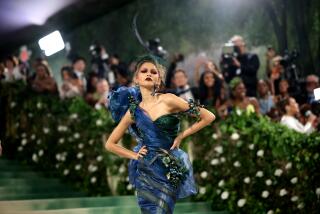ART : A Breath of Fresh Light on Yankee Capitalism
Under the market regime, labor became a commodity. Land came to be seen as an object of speculation. Even literature was a part of trade circulated and promoted by publishing houses.
It sounds familiar, like something from yesterday’s Opinion pages or maybe a threnody from the literary section about the disappearance of serious bookstores in favor of quick-buck discount joints. (Have you noticed there are practically no bookshops left in Beverly Hills?)
Actually, the quote is a description of America in the decades before the Civil War. Written by art historian Elizabeth Garrity Ellis, it’s part of the catalogue for an exhibition of paintings by Fitz Hugh Lane on view at the National Gallery to Sept. 5.
Fitz Hugh who?
Never mind if the name doesn’t resound. Until recently, landscape painters of Lane’s stamp were the closeted companions of scholars who regarded their work as an interesting minor footnote to an epoch dominated by the grandiose talents of Frederic Church, Albert Bierstadt and Thomas Cole, trumpeting the glories of American Manifest Destiny in sensational views almost as big as all outdoors.
Then, in 1980, National Gallery curator John Wilmerding organized a epochal exhibition called “American Light.” He included Lane and related artists such as Martin Johnson Heade, John Frederick Kensett and Sanford Robinson Gifford. They painted landscapes as spare, still and breathless as an afternoon on a deserted beach. We called the style Luminism and it was clear that an important lost piece of American art history had been rediscovered. The restrained work struck a chord in the modern sensibility. Its frozen immobility took on a metaphysical, almost surreal air. Its concern with color-in-light reminded contemporary art buffs of Rothko or Jules Olitski. Californians--stretching the point slightly--saw the Luminists as spiritual ancestors of light-and-space artists such as Robert Irwin and James Turrell.
The paintings seemed the poetic essence of a peculiarly American sort of mysticism that achieves a state of contemplative bliss not by rejecting reality but by scrutinizing it to find the external moods of nature that correspond to the internal quest. It’s the kind of thing that still makes a modern, practical Yank believe that a good nap is the same thing as a yogic alpha state.
Like any truly relevant art, Luminism is linked to the spirit of its times--to the Transcendentalism of Ralph Waldo Emerson with its belief that the divine was to be found not in ideological conventions but in the direct experience of nature. As Ellis points out, Emerson’s idealism initially rejected the booming commercial expansion of the period but later came to embrace the market system as a manifestation of natural law at work.
Many of Lane’s paintings seem to illustrate that point in their depictions of the busy commercial traffic of sailing ships off the shores of his native Gloucester or in Boston Harbor. But thoughts of deified capitalism are probably the last thing that will enter the minds of viewers strolling the exhibition’s galleries in the lower level of the National’s old West Building.
Lane’s paintings are on long, restful formats with low horizon lines and huge serene skies. There is nothing exotic about their subjects for any North American. They show the homely landscape of the East Coast--low rolling hills, untroubled waters, useful and modest buildings, boats going about their business.
These are pictures of what happens on a little weekend getaway to Pismo Beach after endless days of deadlines and traumas in teapots. You finally unwind enough to think that none of that guff matters and the world as it is would be perfectly OK if the yahoos would just let you alone. The ball at the base of your spine unravels pleasantly.
They say happy lives have no history. Maybe that’s why there is little of the noteworthy and none of the spectacular in Lane’s biography, except some grounds for melancholy and contentment. Lane was born in Gloucester in 1804. His legs were partially paralyzed when he was 2, and his sail-maker father died 10 years later.
Grown, he worked part-time as a shoemaker, was apprenticed to a lithographer and became a commercial artist doing signs, ads and sheet music cover illustrations. He made his first oil paintings in 1840 and was soon established as a marine topographer. Within 10 years he was successful enough to build a seven-gable granite house where he lived with his sister and her husband.
Lane never married but was active in the town and played out his life taking trips to Maine, Boston and New York to find subjects for his art. He loved harbors and depicted them in series, as well as boats racing for the America’s Cup. His style was great for sailing vessels, since they appear motionless even when racing. He died at 61 in 1865.
So there you are. No Lautrec-like carousing to cover the psychic pain of his handicap, no Gauguinesque urges for exotic escape. It seems we have to learn about Lane’s quietly troubled soul through his art.
At first he comes off as a kind of naive local working man with a natural philosophical and poetic bent. A picture such as the 1844 “Gloucester From Rocky Neck” has the stiff fussiness and over-elaboration of a kind of draftsman-folk artist. There is already something there in the limpid treatment of sky and water, but the clutter of toylike boats and buildings around the harbor dilutes the effect.
By the 1850s he’d found a way to tightrope between prosaic depiction and a romantic symbolism that recalls the German Caspar David Friedrich. In “Ships on Ice Off Ten Pound Island,” the bleakly beautiful scene is dominated by a big three-masted vessel that stands poised outward bound but frozen in ice. The immobility of the scene enlarges its anecdotal dimensions. The ship seems to stand for Destiny, as it does in so much art from Joseph Conrad to H. C. Westermann. A social historian might see it as a poem about a way of life held in suspended animation. A psychologist might find in it a revelation of Lane’s own paralysis. Either way it resonates beyond itself.
Lane’s world was prosaically graceful, like a young woman whose slight klutziness is part of her charm. He found multiform shadings in his anxious, slow-motion world. Sometimes there’s hallucinatory magic in the reflection of a dinghy on the water, sometimes Turneresque heroics in an off-center composition such as “Sunrise Through the Mist,” or intimations of abandonment in “Brace’s Rock.”
A whole scale of romantic feelings plays through Lane’s pictures, but emotion is both warmly present and coolly observed, as in the moonlit “Fishing Party.” The lunar madness of Ryder is adumbrated here but Lane regards the irrational as just another part of nature. Nothing to be upset about.
In Lane’s day it was commonplace for an artist to make closely related versions of a subject that was commercially successful, or even to paint for a patron a new version of a work that was out of stock. Lane apparently did this. Today the result seems like some kind of serial imagery a la Monet’s haystacks. Two views of Boston Harbor at sunset virtually take the same scene and turn it backward, as if the artist went to the other side for a rear view--or as if he were a philosopher scrutinizing his own hypothesis from every side.
For a modest man, Lane left a legacy that slices a remarkable number of ways--informing the historian who just wants the facts, thrilling the optical aesthete with nuances so careful that light itself seems to be the subject, pure and encompassing.
Maybe the most gratifying subtext in these paintings is simply their stillness. In a world where everything has come to the ephemeral state of a rock video sizzling by on a cold electronic field, it is comforting to be reminded that there are things worth sitting still for, deepening experience not through surface movement but through concentrated, absorptive immobility that rests, reading life like a trusted old book.
More to Read
The biggest entertainment stories
Get our big stories about Hollywood, film, television, music, arts, culture and more right in your inbox as soon as they publish.
You may occasionally receive promotional content from the Los Angeles Times.






